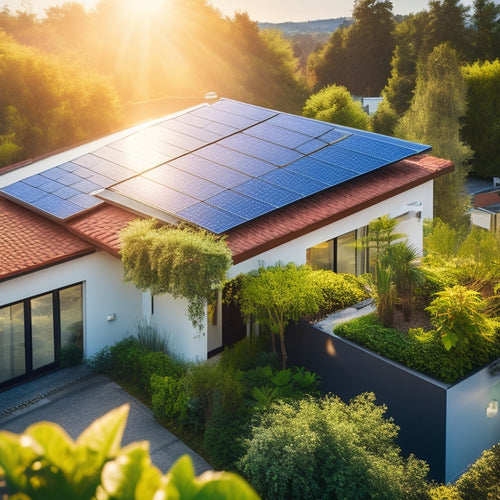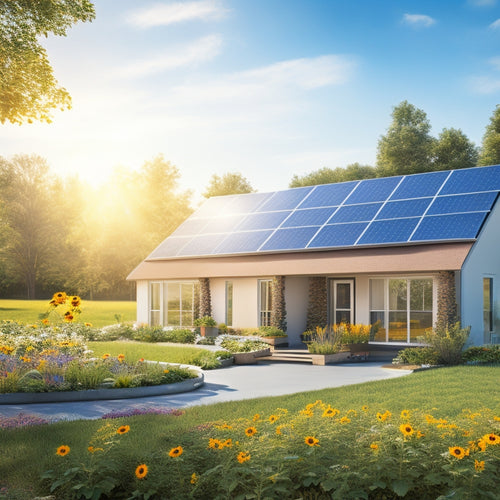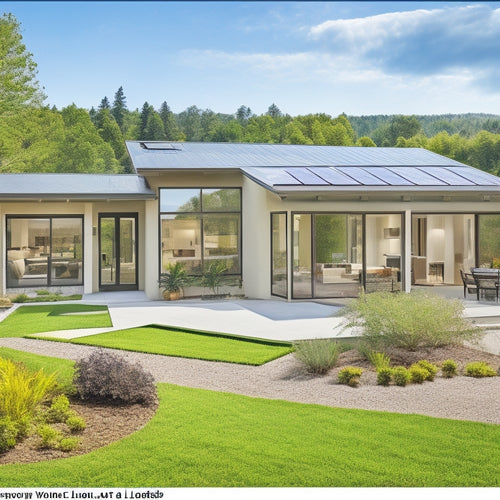
What Is the Cost Per Solar Panel Installed for Your Home
Share
Your cost per solar panel installed for your home depends on several factors, including the size and complexity of the installation, the type of solar panels you choose, and the financing options you select. On average, the cost per watt installed ranges from $2.75 to $3.25, with smaller systems costing more per watt than larger ones. Government incentives, contractor skill level, and installation location also influence prices. By understanding these factors, you can make an informed decision about your solar investment. As you investigate your options, you'll uncover more details that will help you tailor a solar solution to your specific needs.
Key Takeaways
- The average cost per watt installed for solar panels ranges from $2.75 to $3.25, depending on the system size and installation complexity.
- Small systems (2-5 kW) cost $3.00 to $3.50 per watt, while larger systems (10-20 kW) cost $2.50 to $3.00 per watt.
- Higher-efficiency solar panels, such as monocrystalline, may have a higher upfront cost but reduce overall cost per watt.
- Government incentives, financing options, and installation location can influence the overall cost per solar panel installed for your home.
- The type of solar panel chosen, such as monocrystalline, polycrystalline, or thin-film, affects the cost per watt and overall energy production.
Understanding Solar Panel Costs
As you venture into the world of solar energy, one of the most vital factors to assess is the cost of installing solar panels. This investment can be substantial, but it's important to take into account the long-term benefits and savings.
When calculating the overall cost, you'll need to factor in the initial installation price, financing options, and ongoing maintenance costs.
The initial investment includes the cost of the solar panels, inverters, mounting hardware, and installation labor. Financing options, such as loans or power purchase agreements, can help spread the upfront cost over time. Be sure to research and compare financing options to find the one that best suits your needs.
In addition to the initial investment, you'll need to evaluate ongoing maintenance costs. While solar panels require minimal upkeep, you'll still need to budget for occasional cleaning, inspections, and potential repairs.
Average Cost Per Watt Installed
Your solar panel system's overall cost is largely determined by its power output, typically measured in watts (W). The average cost per watt installed is a key metric to understand when evaluating solar panel systems.
The average price per watt installed varies depending on the system's size, efficiency, and quality. Currently, the average cost per watt installed is around $2.75 to $3.25.
Here's a breakdown of the average cost per watt installed for different system sizes:
- Small systems (2-5 kW): $3.00 to $3.50 per watt
- Medium systems (5-10 kW): $2.75 to $3.25 per watt
- Large systems (10-20 kW): $2.50 to $3.00 per watt
When evaluating solar panel systems, it's crucial to contemplate the solar efficiency, which affects the overall cost per watt installed.
Higher-efficiency systems may have a higher upfront cost but can provide more power per unit area, reducing the overall cost per watt installed.
Factors Affecting Installation Prices
While evaluating the average cost per watt installed, you've likely wondered what drives these prices. Several factors contribute to the final installation cost of your home's solar panel system.
Government incentives, for instance, can greatly reduce your upfront costs. Federal and state tax credits, as well as rebates, can shave off a substantial amount from your total bill. Financing options also play a vital role, as they can affect your overall expenditure. You may opt for a loan, lease, or cash payment, each with its unique implications on your wallet.
The installation location also influences the final cost. Rooftop installations, for example, may require additional labor and materials, increasing the price. On the other hand, ground-mounted systems can be more cost-effective.
The skill of your chosen contractor is another important factor. A reputable and experienced contractor may charge more than a novice, but their knowledge can lead to a more efficient and durable system.
Understanding these factors will help you make an informed decision when investing in a solar panel system for your home.
Type of Solar Panels Matter
Investigate the solar panel market, and you'll quickly uncover a wide range of options. The type of solar panels you choose can greatly influence the overall cost of your installation.
Here are three key types of solar panels to evaluate:
-
Monocrystalline panels: These high-efficiency panels are made from a single crystal of silicon, making them more expensive but also more efficient. They're ideal for homeowners with limited roof space who want to maximize energy production.
-
Polycrystalline panels: These panels are made from multiple crystals of silicon, making them less expensive but slightly less efficient. They're a popular choice for homeowners who want a balance between cost and energy production.
-
Thin-film panels: These panels are made from a thin layer of photovoltaic material, making them the least expensive option. However, they're also the least efficient and may not be suitable for residential installations.
When selecting solar panels, evaluate your energy needs, budget, and roof space.
While monocrystalline panels may offer higher efficiency, polycrystalline panels can provide a more affordable option without sacrificing too much energy production.
Installation Size and Complexity
You're likely to find that the size and complexity of your solar panel installation play a significant role in determining the overall cost. A larger installation requires more materials, labor, and permits, increasing the cost per solar panel.
For instance, a 10-kilowatt system will cost more than a 5-kilowatt system, even if the cost per watt remains the same. Moreover, complex installations, such as those with multiple roof angles or shading issues, require more labor and specialized equipment, driving up the cost.
You'll need to factor in installation permits, which vary by location and can range from a few hundred to several thousand dollars. Labor rates also play a significant role, as more complex installations require higher-skilled labor, which comes at a premium.
In addition, complex installations may require additional equipment, such as inverters or tracking systems, which add to the overall cost. By understanding the impact of installation size and complexity on the cost per solar panel, you can better plan and budget for your solar panel installation.
Frequently Asked Questions
What Is the Typical Warranty Period for Solar Panels?
You're likely to get a 25-year warranty for your solar panels, which covers defects and performance guarantees, ensuring a long solar panel lifespan with reliable warranty coverage for your energy-hungry home.
Can I Install Solar Panels on a Metal Roof?
You can install solar panels on a metal roof, leveraging its advantages like durability and water-tightness, but be prepared to overcome installation challenges like specialized mounting systems and potential corrosion issues.
Do Solar Panels Work During Power Outages?
Did you know 72% of homeowners prioritize energy independence? You're wondering if solar panels work during power outages. Unfortunately, they don't provide emergency power during grid outages due to safety and efficiency reasons, as solar panel efficiency relies on grid connection.
Are There Any Government Incentives for Solar Panels?
You can benefit from government incentives for solar panels, including federal tax credits that cover up to 26% of installation costs, and state rebates that vary by location, greatly reducing your upfront investment.
Can I Sell Excess Energy Back to the Grid?
You can sell excess energy back to the grid through net metering, earning energy credits that offset your utility bills; this program allows you to store excess energy and redeem it when needed, maximizing your solar panel investment.
Conclusion
As you weigh the benefits of solar energy for your home, don't let uncertainty about costs hold you back. While the average cost per watt installed may seem steep, consider that prices have dropped considerably over the years. Plus, with incentives and long-term savings, solar panels can pay for themselves. Yes, installation size and complexity can drive up costs, but a reputable installer can guide you through the process. And, with high-quality panels, you'll reap the rewards of a reliable, eco-friendly energy source for years to come.
Related Posts
-

Solar Power Systems for Cost-Effective Sustainability
Investing in solar power systems is a smart move for cost-effective sustainability. You can save about $1,500 annuall...
-

Home Solar Systems for Environmental Impact
Home solar systems markedly reduce your carbon footprint by utilizing renewable energy. By adopting solar energy, you...
-

Passive Solar Design Strategies for Homes
To effectively implement passive solar design strategies in your home, focus on ideal building orientation and strate...


